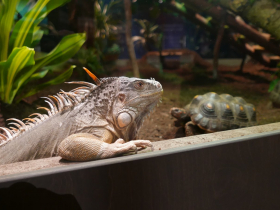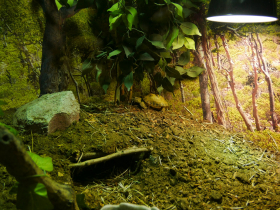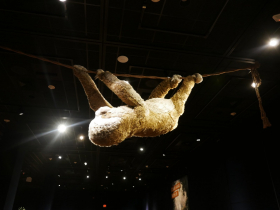Public Museum Adding Live Animal Exhibit
Sloths, iguanas, tortoises and more part of new exhibit called "Survival of the Slowest."
This weekend, the Milwaukee Public Museum is opening a new exhibit featuring live animals for the first time since the COVID-19 pandemic.
The exhibit, called “Survival of the Slowest” showcases some of the unique ways animals adapt to their habitats. The traveling exhibit features animals such as tortoises, tarantulas, lizards and snakes. But the star of the show is the two-toed sloth.
Survival of the Slowest, from Little Ray’s Exhibitions, includes 19 different habitats that will give attendees opportunities to observe the animals up close. The last live-animal Exhibit was “Spiders Alive!” in 2019. And the animals in “Survival of the Slowest” are some of the biggest live-animals the museum has exhibited, said Jon Bertolas, the MPM on-site curator for the new exhibit.
“You’re gonna get up and close with animals you’re not always going to see,” said Sara Marsano, a zookeeper with Little Ray’s, during a media preview Friday. “And the people who work here are just so passionate about the animals.”
The exhibit is all about the “counterintuitive” ways animals have evolved to survive in their habitats. “So most people know being bigger, stronger, faster, tend to be the most beneficial ways of living in the environment,” Marsano said. “But that’s not always the case.”
She used the two-toed sloth as an example. These animals sleep 16-20 hours a day, and they don’t move around much, but they also eat leaves that none of the other animals eat, so they don’t have much, if any, competition for food. “They can wake up, eat a snack, go back to bed,” she said. “It’s fantastic.” Also, predators are less likely to notice you if you’ve been motionless, sleeping in a tree for hours, she explained.
Bertolas, who also supervises the museum’s Puelicher Butterfly Center, said the live animal exhibits give families opportunities to interact with the animal care staff and ask questions about the animals. “People are able to observe the behaviors of the animals in person, you’re able to make a connection, and learn something without even reading anything,” he said.
The ability to learn through simple observation is part of what makes the live animal exhibits so exciting for visitors, Bertolas said, adding that its the same dynamic that makes the museum’s famous dioramas so successful. That said, the museum still will provide plenty of literature and written information will the exhibits.
Marsano travels all over the country with these exhibits, and she hopes that putting people within arms reach of a green iguana, even if separated by glass, will help them begin to care more about animals that live in the wild. On top of that, she’s seen the exhibits break down some of the fear and misconceptions related to animals like tarantulas and snakes.
Kids come to the exhibits and, like most people, they’re scared of tarantulas. “I talk about the tarantula, I let the kid give the tarantula a little high five,” she said, “and suddenly they love spiders.”
The new exhibit opens to the public Saturday, Feb. 11 and will run until May 19. Tickets can be purchased on the museum’s website.
Photo Gallery
If you think stories like this are important, become a member of Urban Milwaukee and help support real, independent journalism. Plus you get some cool added benefits.

























